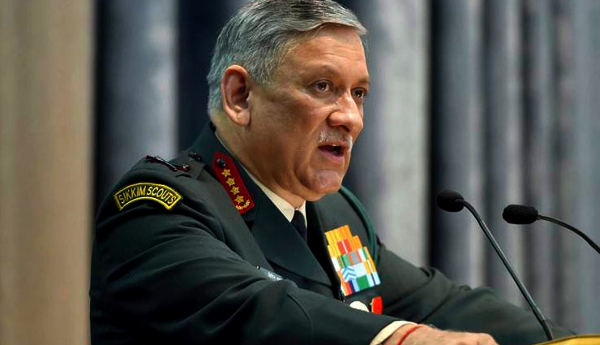New Delhi: The Navy will provide crucial intelligence to the upcoming theatre commands at the northern and western borders once they start taking shape next year, Chief of Defence Staff (CDS) General Bipin Rawat has said.
In a conversation with a limited group of journalists Thursday on integration plans of the Services, Rawat said the process to set up the theatre commands should begin by mid- or late-2021. However, their exact number at the northern and western borders will be based on ongoing threat assessments.
The CDS said while these theatre commands are expected to primarily serve as integration between the Army and the Indian Air Force (IAF), they will require naval assets too.
“I would say there is very much a requirement of a Navy person. There are some resources that the Navy has which can be used at the northern borders. The surveillance resources of the Navy which are used at sea can be effective on land too,” said Rawat, who has the task to improve integration between the three Services as India’s first CDS.
The Navy uses a variety of equipment to carry out maritime surveillance. Out of these, the P8I aircraft and unmanned aerial vehicles (UAVs) could possibly be used on the land borders. For instance, the P8I anti-submarine warfare aircraft was deployed to carry out surveillance on movement of Chinese troops during the 73-day long Doklam standoff between India and China in 2017.
Rawat said the Navy’s fighter aircraft, which is currently limited to operate at the sea, could also be integrated with these theatre commands. The Navy’s fighter aircraft squadron comprise the MiG-29Ks.
The CDS said if the Navy’s fighters have not flown at high altitudes, they could be brought to Jaipur in the Western Command and the existing assets there could be moved to the northern borders for operational roles.
A theatre command will have specific units of personnel from the three services — Army, Navy and Air Force — under a common commander so they fight as a cohesive unit. Both the US and China follow a theatre command doctrine.
“Within three years, the operational directions to get the theatre commands will be issued. Then in some timeline they will be taking shape,” added Rawat.
‘Will prevent fratricide’
As part of the integration process, the three Services’ air defence under an Air Defence Command is the first on the block, said General Bipin Rawat.
Speaking about its expected start, the CDS said, “The study is going on there (on air defence command), and we are quite hopeful that by the end of this year, we should issue the implementing instructions and the coordination should start.
“Gradually in a year or two, the complete air defence should get integrated,” he said.
The CDS said the defence of the airspace is critical and somebody has to be responsible for that. “That responsibility has been given to the IAF. But the resources to defend the air space are with three separate services. Should this not be coordinated? Or should you keep hitting your own aircrafts and UAVs?”
According to him, this integration implies having Air Defence Command operational directives, which will be applicable to the air defence assets of the Army, Navy and the IAF.
“If you have to ensure there is no fratricide, for every weapon system fired in the right time at the right aircraft, the command and control instructions should come from one entity. As of now it’s not,” he said.
On 27 February 2019, a surface-to-air missile of the IAF brought down the force’s own Mi-17 V5 helicopter in Budgam in the Kashmir Valley, killing six personnel on board and a civilian on ground, in a case of fratricide. The incident happened when the IAF and the Pakistan Air Force were engaged in a dogfight, a day after the IAF’s Balakot strikes.
Rawat added that the arrangement will be different under some circumstances. For instance, on a naval ship going to high seas, its air defence resources will be controlled by the person commanding the ship.
The CDS added that an integrated maritime command, which will be under the Navy, is also being studied.
“Today the ships are operational under different commanders, but it is being seen if the command and control of the ships can be exercised by one entity as the maritime commander,” he said.
“That is the next thing we are looking at,” he said, adding that the command could up by early next year.
On communication, training
General Bipin Rawat also stressed the need for a common communication system as part of the integration. As of now, all three Services use different systems.
“An order is issued by the highest authority should reach the lowest authority in the fastest time frame and that can only happen if your communication is integrated,” he said.
“Training systems, establishments, will be common… the equipment of the services has to be common. Today each one is contracting their own,” he said. “So maintenance and logistics should be common and there will be a huge saving in maintenance.”
The CDS added that there are also plans to integrate the administrative elements of the services as a measure to save costs.
Source: Print
You may also like
-
IAF Aircraft Set Course For Exercise Eastern Bridge VII At Oman
-
IAF Set To Host The Indian Defence Aviation Exposition-II At Jodhpur
-
Defence Secretary to co-chair 5th India-Philippines Joint Defence Cooperation Committee meeting in Manila
-
Simultaneous Launch Of ‘malpe And Mulki’, Fourth And Fifth Ships Of Asw Swc (Csl) Project
-
Aatmanirbharta in Defence: MoD signs Contract with HAL for 240 AL-31FP Aero Engines for Su-30MKI Aircraft
